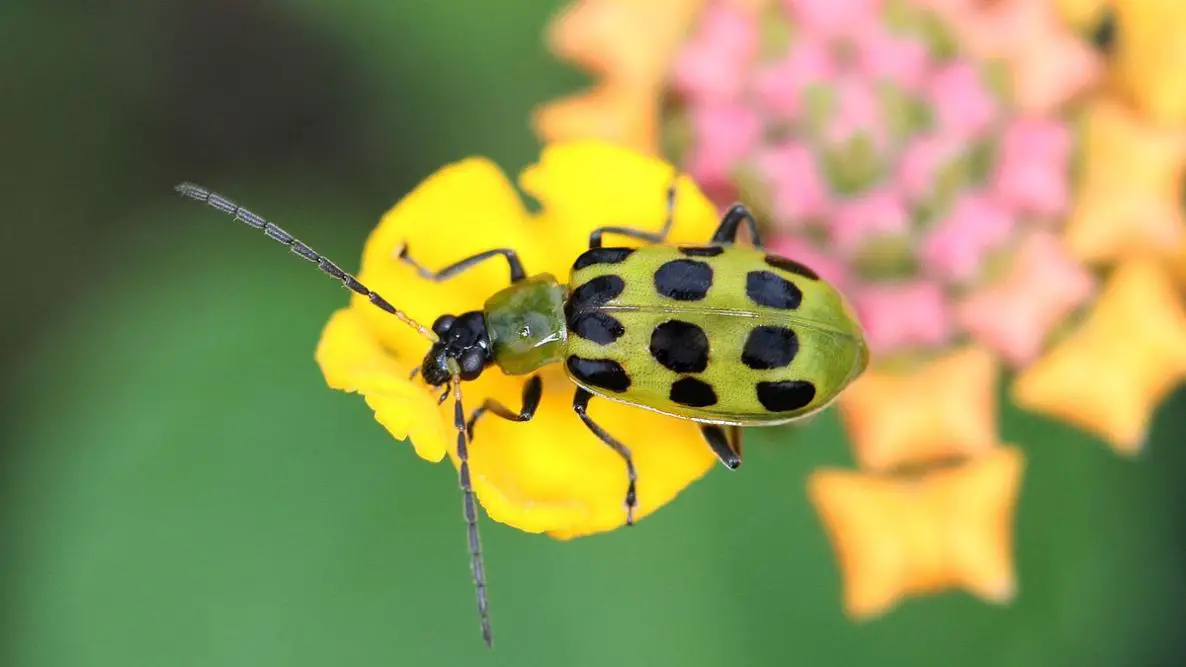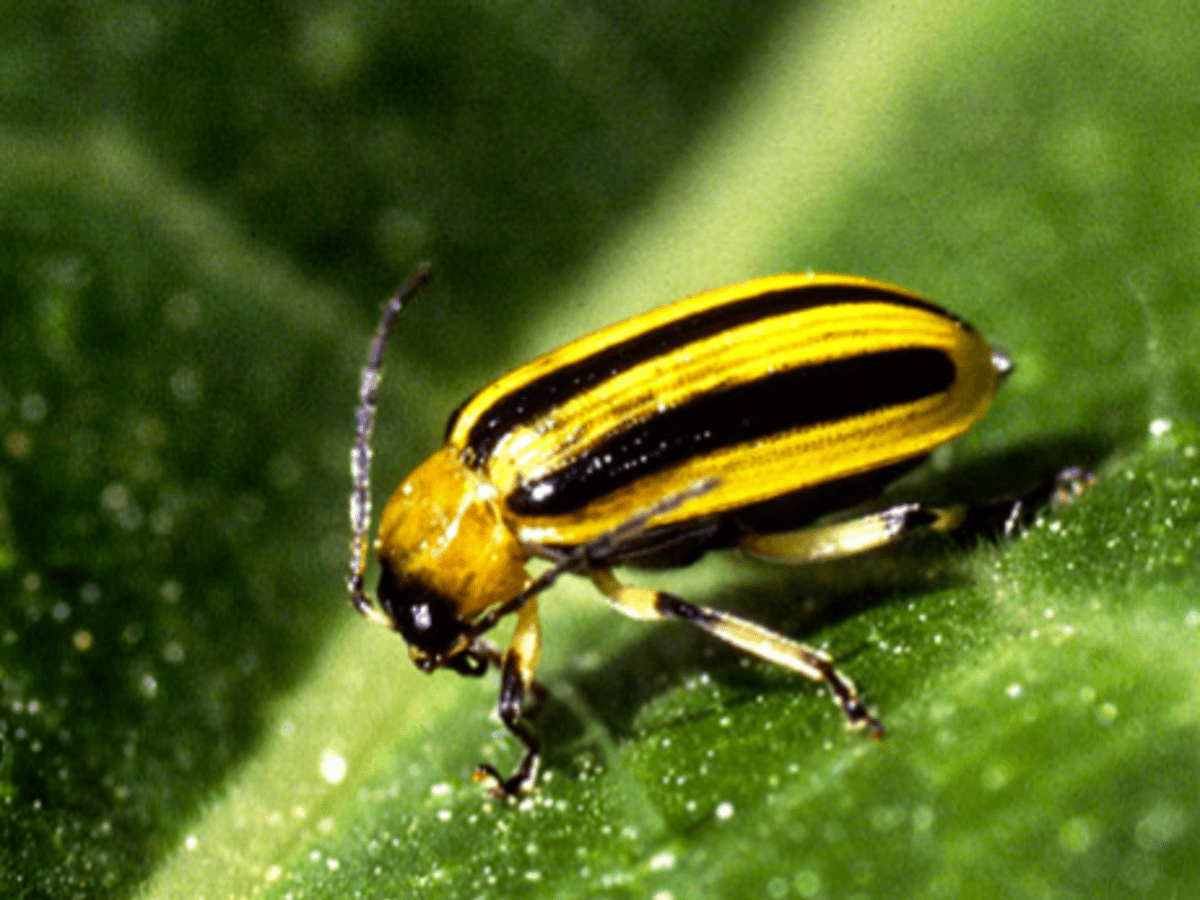Cucumber beetles can cause major disruptions in flowering and fruit development by feeding on seedlings and mature plants alike, interfering with flowering and fruit formation as well as spreading bacteria that infect numerous vegetables and fruits.
Prevention is key when it comes to gardening success, and plants that attract ladybugs and green lacewings that feed on pest eggs may help deter cucumber beetles from entering.
Neem Oil
Cucumber beetles pose a major threat to cucumbers and other garden plants. Both spotted and striped varieties of the insect are widespread across gardens, often wreaking havoc during summer. There are various natural methods available for controlling cucumber beetles as well as other garden pests; it’s best to employ multiple strategies simultaneously in order to avoid an outbreak.
Preventing cucumber beetle infestation begins even before planting day. Tilling and clearing away any weeds early can help discourage insects, decreasing overall population levels. Mulching can also be used effectively as a preventative measure against them laying their eggs in your garden.
Neem oil treatments are an excellent way to deter and kill cucumber beetles in your garden, acting both as an organic insecticide and deterrent. Neem can be applied in two forms – as foliar spray or soil drench applications – without harming beneficial insects that help control population levels.
Spray your crops with pyrethrum – an all-natural compound derived from chrysanthemum flowers that directly kills cucumber beetles on contact. Available as ready-to-use spray such as Fox Farm “Don’t Bug Me” Pyrethrum spray, or as a concentrate that can be mixed with water to create custom solutions that best meet your needs – for another solution to cucumber beetle infestation, another great strategy may be using custom made solutions of your own for your own sprays.
Alternative approaches for controlling cucumber beetle infestations include planting trap crops and taking cultural controls measures, such as using trap crops such as radishes, nasturtiums and tansy. Planting them as trap crops can deter cucumber beetles; building barriers of buckwheat or cowpeas is another effective strategy; crop rotation can reduce risks by rotating fields out more regularly while floating row covers reduce risks further still.
As well as using preventive methods, it is also wise to monitor your crops for signs of cucumber beetles, as these insects can do serious damage if allowed to multiply unchecked. If they appear, remove affected leaves as quickly as possible in order to minimize their impact and thus limit any further spread of bacterial wilt.
Pyrethrin
Cucumber beetles (Dibrotica striped and Dibrotica spotted) are common pests of home vegetable gardens, where they cause damage to plants while interfering with pollination and fruit set. The former features yellow-black stripes on its abdomen; while its counterpart has solid color with 12 black spots. While one variety often causes more harm than another, both can create significant losses.
There are various strategies you can employ to avoid cucumber beetle damage in your garden. Utilizing best gardening practices such as rotating cucurbit crops, controlling weeds, and clearing away debris post harvest can significantly decrease beetle populations in your space. Furthermore, biopesticides utilizing fungus-based pathogens or root-attacking nematodes as biopesticides may also provide useful control measures against larval attacks from cucumber beetles.
However, these methods may not be enough to get rid of adult beetles that feed on leaves and flowers; more aggressive strategies may be necessary in order to tackle such persistent pests effectively.
One effective strategy to address cucumber beetles is through the combination of neem oil and pyrethrin insecticides. Neem oil soap will kill beetles on contact while repelling new beetles for up to two weeks; while pyrethrin, derived from chrysanthemum flowers, is widely considered an organic insecticide with proven effectiveness against cucumber beetles. When selecting products labeled OMRI organic, follow their application directions with care and don’t forget OMRI certification for best results!
Methods to control cucumber beetles include trap crops with pheromones that lure away cucumber beetles from your main crop, like Blue Hubbard squash varieties as a great way of doing this. Your garden should also feature beetle traps to draw them away from other vegetables and trap them before using more potent chemical insecticides to kill them. Reduce the likelihood of beetle transfers transferring bacteria-related wilt to other crops by hanging commercial sticky traps around your plants to capture any beetles not lured in by trap crops, then consider applying foliar sprays of bifenthrin or azadirachtin to kill any remaining cucumber beetles that evade traps.

Natural Predators
Cucumber beetles cause substantial damage to cucurbit crops, leaving scarred fruit that reduces marketability. Pesticides are one effective means of controlling cucumber beetles; however, environmental and preventive strategies may also help keep them in check.
Natural predators and parasites that feed on cucumber beetles can provide some level of control; ladybugs, braconid wasps, green lacewings and nematodes are among those known to prey upon these bugs, providing an effective biocontrol team that may reduce spraying with synthetic insecticides.
Removing weeds that harbor cucumber beetles and their eggs is essential to successful gardening against these pests. Tilling the garden late autumn or early spring can also help eliminate overwintering eggs and larvae, while rotating your garden plots so they do not infiltrate each crop year after year is another great way to safeguard it against cucumber beetle infestations.
When dealing with serious cucumber beetle issues, swift action must be taken immediately to kill off these creatures before their populations swell beyond control. A combination of environmental controls like neem oil and pyrethrins may provide sufficient control, although broad spectrum insecticides like permethrin, bifenthrin, lambda-cyhalothin or carbaryl are effective as these treatments do not penetrate through leaves but only need come into direct contact with cucumber beetles in order to kill it instantly.
Spinosad can also serve as an effective short-term control agent, when applied through misting systems or soil drenching techniques. This substance should only be applied once every few months to plants surrounding yours for best results. As it does not harm beneficial insects or pollinators, cucumber beetle control using this approach may be effective combined with other strategies. However, for optimal results it would be more prudent to utilize integrated pest management techniques for prevention purposes. Simple steps like these can make all the difference between a fruitful harvest and one that fails completely, not only with cucumbers but also squash, pumpkins and other cucurbits. Preventing pests by creating an effective integrated management plan and protecting from them are crucial elements to success in any garden.
Traps
Cucumber beetles feed on young plants, leading to defoliation. Furthermore, these beetles carry the disease known as bacterial wilt that attacks cucumbers, melons, pumpkins, and squash. Infected plants become infected through mouthparts of beetles or from their feces, and symptoms include daytime wilting but nighttime recovery or progresses to plant death. The best way to stop further spread of this bacterial wilt outbreaks is removing infected plants as soon as possible for field crops – however this may not always possible due to restrictions placed by regulations such as field crops being protected.
Cucumbers and other cucurbits can be protected with floating row covers when planted. Covering will trap heat and humidity for better soil moisture retention, which in turn helps prevent damage from cucumber beetles. In addition, keeping weeds down will lower beetle attraction to the crop.
Other methods for prevention include trap crops that use pheromone-lured crops as bait and the use of natural predators and beneficial nematodes as soil drenches; beneficial nematodes can kill beetles during their pupal stage while ladybugs, green lacewings and assassin bugs all prey upon various life stages of beetles.
Pyrethrum is an organic broad-spectrum insecticide derived from African chrysanthemum flower heads that provides effective pest control against many varieties of insects including cucumber beetles. Unfortunately, its toxic to beneficial insects so should be used sparingly to avoid damaging them too severely.
Cucumber beetle traps can be created by layering hay, straw or fabric at the bottom of a container and filling the traps with equal parts sugar and molasses mixed as bait to lure beetles in. Once filled, these traps should be set near vulnerable crops in order to catch and kill any beetles present; in one test they were found to be over 95% effective at killing cucumber beetles when combined with other methods like pheromones and trap crops; best time setting this method would be evening when most beetles would be active.

